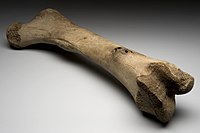
Photo from wikipedia
To compare the histological healing and radiographic effects of tendons transferred to ossified or unossified bone using different tendon fixation techniques Nine new-born piglets underwent bilateral tendon transfers to either… Click to show full abstract
To compare the histological healing and radiographic effects of tendons transferred to ossified or unossified bone using different tendon fixation techniques Nine new-born piglets underwent bilateral tendon transfers to either the ossified boney calcaneal body or unossified apophysis. The tendons were fixed using metallic suture anchors, sutures alone or a bone tunnel. At six weeks of age, calcanei were harvested, radiologically imaged and then prepared for histology. A semi-quantitative aggregated scoring system with values ranging from 0 (poor) to 15 (excellent), was used to grade healing at the surgical enthesis and the apophyseal ossification was graded by five independent reviewers in triplicate using a modified (1 to 4) validated scoring system. Histologically, the cartilaginous transfers utilizing the tunnel and suture techniques also demonstrated the best average aggregated scores of entheses healing rivalling that measured in transfers using the classic bone tunnel technique (clinical benchmark), whereas suture anchor fixation demonstrated the worst healing in both the ossified and unossified samples. All three transfer techniques caused at least minor alterations in apophyseal ossification, with the most significant changes observed in the metallic suture anchor cohort. The tunnel and suture techniques demonstrated similar and more mild abnormalities in ossification. Tendon transfers to unossified bone heal histologically as well as transfers classically performed through tunnels in bone. Suture fixation or tunnel techniques appear radiographically and histologically superior to suture anchors in our newborn porcine model.
Journal Title: Journal of Children's Orthopaedics
Year Published: 2021
Link to full text (if available)
Share on Social Media: Sign Up to like & get
recommendations!